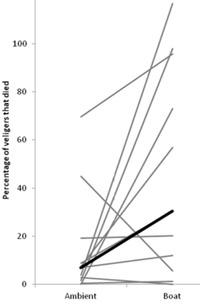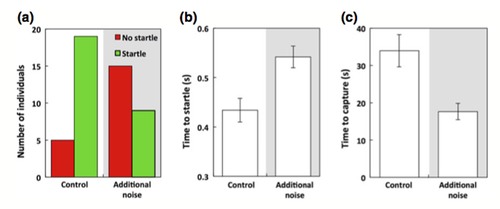More evidence that ship noise can have dramatic impacts on non-cetacean sea life
Animal Communication, Bioacoustics, Human impacts, Ocean, Science, Shipping Add commentsAEI lay summary of four recent papers:
Simpson SD, Purser J, Radford AN (2014). Anthropogenic noise compromises antipredator behavior in European eels. Global Change Biology (2014), doi: 10.1111/gcb.12685
Voellmy IK, Purser J, Simpson SD, Radford AN (2014). Increased Noise Levels Have Different Impacts on the Anti-Predator Behaviour of Two Sympatric Fish Species. PLoS ONE 9(7): e102946. doi:10.1371/journal.pone.0102946
Nedelec SL, Radford AN, Simpson SD, Nedelec B, Lecchini D, Mills SC (2014). Anthropogenic noise playback impairs embryonic development and increases mortality in a marine invertebrate. Sci. Rep. 4, 5891; DOI:10.1038/srep05891 (2014).
Erica Staaterman, Claire B. Paris, Andrew S. Krough (2014). First evidence of fish larvae producing sounds. Biol. Lett. 2014 10, 20140643.
It used to be that most concern about human noise and ocean life was centered on whales and the two loudest sound sources: sonar and seismic surveys. But in recent years, we’ve seen a growing wave of studies looking at how chronic, moderate ship noise can interfere with normal behavior and development of other creatures, including squid, fish, crustaceans, and other “lower” species. Four recent studies add to the list of known or suspected ways that shipping and recreational boat noise may be wreaking previously unsuspected havoc throughout the oceanic web of life.
The most dramatic results came in a study of eels’ responses to predators (above). When exposed to ship noise, only half as many eels responded to an ambush attack from a predator (just 38% reacted, down from 80%); and, those that did react did so 25% slower than normal. Likewise, researchers tested eels’ ability to detect a “pursuit” predator that follows the eels before attacking; in this case, the eels in ship noise were caught twice as quickly. Looking deeper, the researchers examined how noise affects metabolic rates, stress, and breathing rates, and an interesting feature of eel life, the preference for using one side of their body when interacting with other eels and when hunting. The researchers explain:
“In the same way we write using our right or left hands, fish have a preferred side to approach a predator or to stay next to shoal mates with. We watched each eel as it explored a maze in ambient conditions to classify its right or left bias, then we exposed half to ship noise and half to more ambient noise. Their preferences went away when they were exposed,” says Dr Steve Simpson of the University of Exeter, lead researcher on the study. The team suspect this means ship noise affects eels’ cognitive processes, which could mean other processes, like learning, may also be affected. Alongside raised metabolic and ventilation rates, the scientists note the stress being caused by the shipping noise is similar to the levels fish exhibit in ocean acidification studies.
“We know shipping isn’t going to stop, but we can do things like move a shipping lane so it doesn’t interact with the migrations paths of animals,” Simpson suggests. “It’s a pollutant we have more control over than something like atmospheric carbon dioxide. These animals are having to deal with all the stressors globally, so if we can alleviate just one it might give the animals more resilience to other stressors like ocean acidification, which will come later.”
A study of two species of small fish highlights species differences and the ways that noise can alter behavior in unexpected ways. Here, one species of fish exposed to ship noise actually responded more quickly to the presence of a predator,
while another showed no obvious change. The quicker response could, of course, be beneficial; the researchers speculate that the noise may put them into a higher state of vigilance, or, with hearing masked, they may rely more than normal on visual stimuli. And while these quicker responses could lead to higher survival of attacks, there is also a flip side to reacting more quickly than normal; as researchers note (referencing previous studies on similar issues):
However, responding faster reduces time available for threat assessment and may lead to suboptimal decisions, such as premature flight responses to non-threatening situations. If fleeing individuals seek shelter, and do not emerge for some time, such ‘escapes’ not only result in unnecessary energy expenditure, but may also lead to lost opportunities for foraging or reproduction. In turn, compensation for lost foraging time may carry costs of increased predation risk, if animals are forced to forage during times of greater predatory threat.
 Some of the most groundbreaking new work is looking at the effects of noise on physical development during larval and adolescent stages of life. In our third new paper, the sound source was not large ships, but small outboard motorboats. The results were not as dramatic as with the eels, and had a fair degree of variability, but on average there was about a 20% increase in the number of sea slug eggs that failed to develop, and a similarly higher mortality rate among those that did hatch. Interestingly, looking at the graphs of each test treatment, it’s clear that non-development is common with or without noise, and while it occurred more often in noise, the percentage of eggs not hatching was unchanged. Conversely, though, the survival rates of hatched sea slugs was often very dramatically affected in the noise treatment (left; dark line is the mean); in four of the 11 tests, mortality of these young slugs skyrocketed from near-zero in ambient conditions to over half with boat noise. Co-author Dr Andy Radford of the University of Bristol, said: “This is the first indication that noise pollution can affect development and survival during critical early life stages (ed. note: actually, see also that link just above). Growing evidence for the impact of noise on animals suggests that consideration should be given to the regulation of human activities in protected areas.” Simpson was a co-author on this paper as well, and he noted, “Boat noise may cause stress or physically disrupt cells during development, affecting chances of survival.” As the paper concludes:
Some of the most groundbreaking new work is looking at the effects of noise on physical development during larval and adolescent stages of life. In our third new paper, the sound source was not large ships, but small outboard motorboats. The results were not as dramatic as with the eels, and had a fair degree of variability, but on average there was about a 20% increase in the number of sea slug eggs that failed to develop, and a similarly higher mortality rate among those that did hatch. Interestingly, looking at the graphs of each test treatment, it’s clear that non-development is common with or without noise, and while it occurred more often in noise, the percentage of eggs not hatching was unchanged. Conversely, though, the survival rates of hatched sea slugs was often very dramatically affected in the noise treatment (left; dark line is the mean); in four of the 11 tests, mortality of these young slugs skyrocketed from near-zero in ambient conditions to over half with boat noise. Co-author Dr Andy Radford of the University of Bristol, said: “This is the first indication that noise pollution can affect development and survival during critical early life stages (ed. note: actually, see also that link just above). Growing evidence for the impact of noise on animals suggests that consideration should be given to the regulation of human activities in protected areas.” Simpson was a co-author on this paper as well, and he noted, “Boat noise may cause stress or physically disrupt cells during development, affecting chances of survival.” As the paper concludes:
Outboard motor boats are found all over the world wherever humans inhabit coastal areas and our results suggest that noise from them should be considered in the management of fisheries and protected areas. Other sources of anthropogenic noise, such as ships, seismic surveys and pile driving, may also overlap with developmental stages of vulnerable species, raising concern for many populations.
The final recent paper I want to mention is notable for being the first time that reef fish larvae have been recorded making sound. In recent years, it’s become clear that some reef larvae orient toward the sound of reefs as they make their way back to settle after an early life stage of drifting, but here the larvae of gray snapper, and important commercial fish, were directly recorded in their natural habitat (the tests involved putting larval fish in mesh containers at sea, with hydrophones nearby). The larvae made two sounds, “knocks” and “growls,” that are similar to those made by adults. The larvae only made sounds at night, suggesting that they serve a function that is otherwise unobtainable at night, but achieved by other means during the day—most likely social cohesion (maintaining their group); this species often is found in large aggregations, even during larval stages. The obvious concern is whether these acoustic signals may be masked by boat noise, increasing the risk of separation and/or predation; indeed, 6 of the 22 test recording periods included the sound from boats that made the larval sounds too difficult to effectively analyze. As the researchers conclude:
Fish larvae are not just listeners. Even without understanding the function of the sounds they emit, their mere existence prompts exciting research questions. How important is the contribution of planktonic organisms to pelagic soundscapes? Larval fish orient towards sounds of settlement habitat, but will they also orient towards sounds of conspecifics? Acoustic masking from boats occurred in this study, and anthropogenic noise in the ocean is on the rise. What are the consequences if larval fish sounds become undetectable? Our results reveal that the acoustic ecology of larval fishes is a research area rich in opportunity and discovery.

